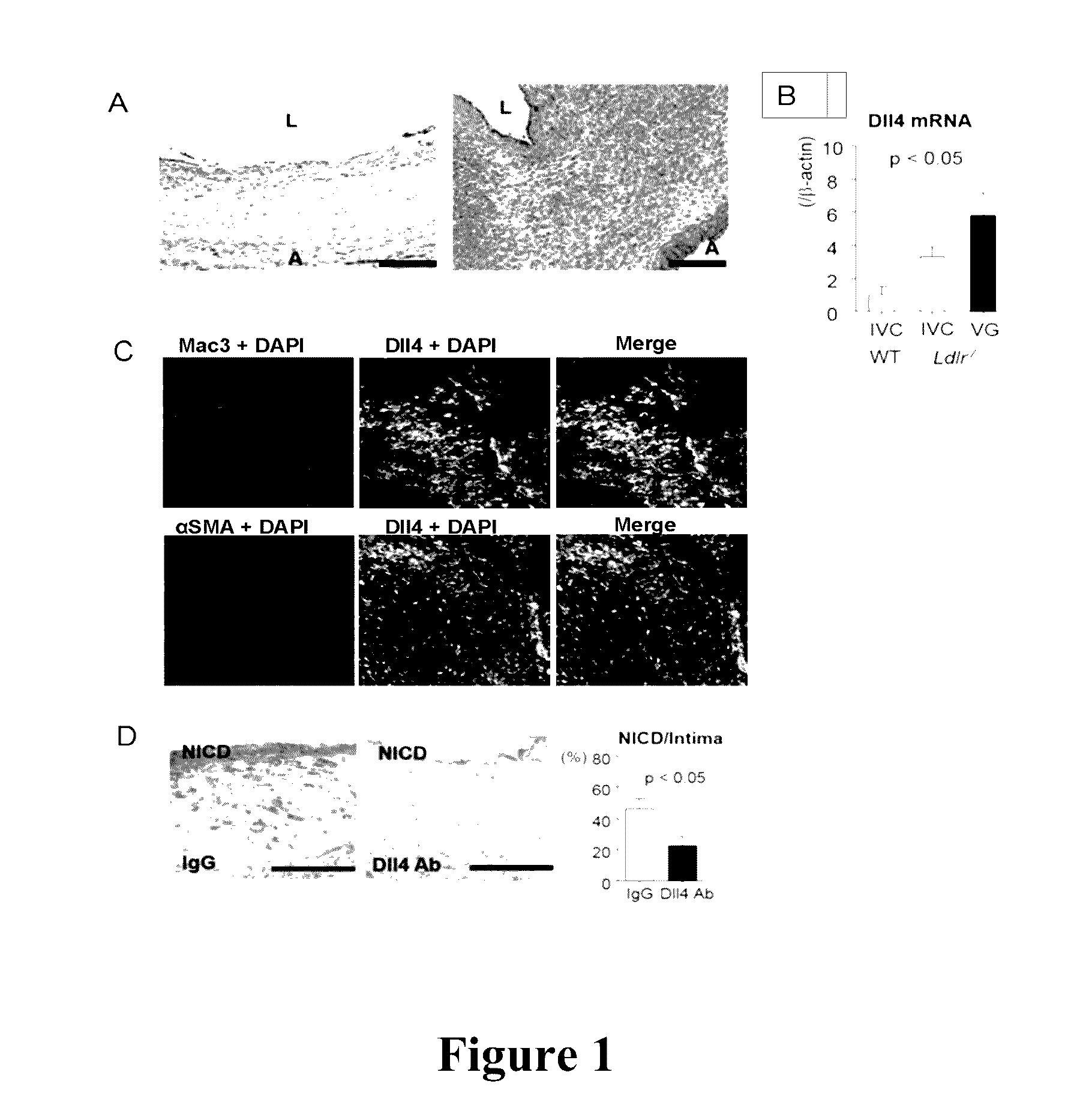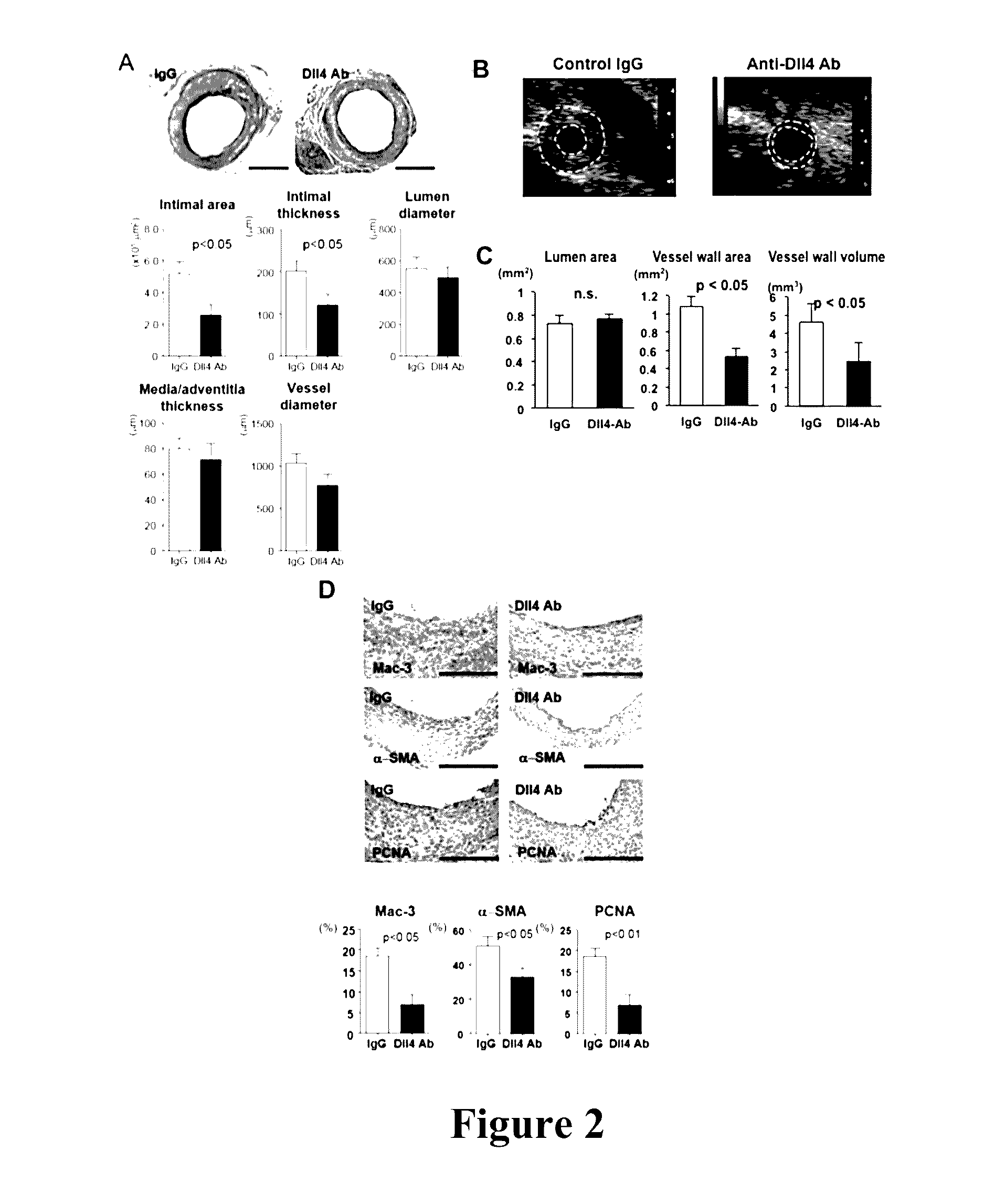Notch inhibition in the prevention of vein graft failure
a vein graft and inhibition technology, applied in the field of treating patients to prevent vein graft failure, can solve the problems of devastating limb amputation or invasive and expensive angioplasty or surgical revascularization, no effective medical solution is available for vein graft failure, and the pathogenesis of vein graft failure remains incompletely understood. to achieve the effect of preventing vein graft failur
- Summary
- Abstract
- Description
- Claims
- Application Information
AI Technical Summary
Benefits of technology
Problems solved by technology
Method used
Image
Examples
example 1
Delta-Like 4 Induces Notch Signaling in Macrophages: Implications in Inflammation
[0057]The Notch family members (Notch1-4) are large type I transmembrane receptors that undergo proteolytic processing by a furin-like convertase during transit to the cell surface (Logeat, et al., Proc. Nat'l Acad. Sci. USA 95:8108-8112 (1998)). Binding of a ligand—Delta-like 1 (Dll1), Delta-like 3 (Dll3), Delta-like 4 (Dll4), Jagged1, or Jagged2—triggers sequential receptor cleavage by ADAM-type metalloproteinases and gamma-secretase, resulting in the liberation and nuclear translocation of Notch intracellular domain (NotchICD) (Selkoe, et al. Annu. Rev. Neurosci. (2003)). NotchICD association with the sequence-specific DNA-binding factor RBP-Jkappa / CBF-1 leads to the formation of a transcriptional activator complex that induces the transcription of Notch target genes. In the present example, data is presented showing that Dll4 expression increases in activated human macrophages, and that Dll4 binding...
example 2
Notch Signaling Induces Macrophage Gene Expression Associated with Inflammation and Atherosclerosis
[0088]The present example presents results that demonstrate that Notch signaling regulates the induction of various proinflammatory genes, suggesting that this pathway participates in macrophage activation and the pathogenesis of inflammatory diseases including atherosclerosis.
[0089]A. Methods
[0090]Cell Culture
[0091]RAW 264.7 cells were from American Type Culture Collection (ATCC), and were grown at 37° C. under 5% CO2 in Dulbecco's modified Eagle's medium (DMEM, Gibco) supplemented with 10% fetal bovine serum (BioWhittaker), 4 mM L-glutamine, 50 U of penicillin G / ml, and 50 mg of streptomycin / ml.
[0092]Plasmid Construction and Purification
[0093]Plasmid DNA constructs encoding FLAG-tagged intracellular domains of mouse Notch1 (N1ICD), Notch2 (N2ICD), Notch3 (N3ICD), the dominant negative mastermind-like protein 1 (DNMAML1) and eGFP were amplified in chemically competent E. coli, purifie...
example 3
Studies Related to Vein Graft Failure
[0123]The present example examines the hypothesis that Notch signaling promotes vein graft disease. It was found that Dll4 antibody administration for 28 days inhibited lesion development of vein grafts in LDL-receptor deficient (Ldlr− / −) mice, and suppressed macrophage accumulation and macrophage expression of pro-inflammatory M1 genes. Dll4 antibody treatment for 7 days after grafting also reduced macrophage burden at Day 28. Dll4 silencing via macrophage-targeted lipid nanoparticles reduced lesion development and macrophage accumulation. Gain-of-function and loss-of-function studies suggested in vitro that Dll4 induces pro-inflammatory molecules in macrophages. Macrophage Dll4 also stimulated smooth muscle cell (SMC) proliferation and migration and suppressed their differentiation. It may be concluded that macrophage Dll4 promotes the lesion development of vein graft, supporting the Dll4-Notch axis as a novel therapeutic target.
[0124]A. Method...
PUM
| Property | Measurement | Unit |
|---|---|---|
| concentration | aaaaa | aaaaa |
| real time PCR | aaaaa | aaaaa |
| thickness | aaaaa | aaaaa |
Abstract
Description
Claims
Application Information
 Login to View More
Login to View More - R&D
- Intellectual Property
- Life Sciences
- Materials
- Tech Scout
- Unparalleled Data Quality
- Higher Quality Content
- 60% Fewer Hallucinations
Browse by: Latest US Patents, China's latest patents, Technical Efficacy Thesaurus, Application Domain, Technology Topic, Popular Technical Reports.
© 2025 PatSnap. All rights reserved.Legal|Privacy policy|Modern Slavery Act Transparency Statement|Sitemap|About US| Contact US: help@patsnap.com



